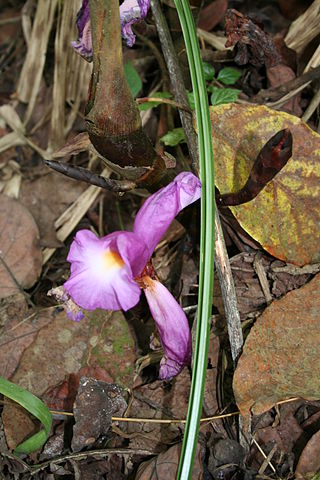
Zingiberaceae or the ginger family is a family of flowering plants made up of about 50 genera with a total of about 1600 known species of aromatic perennial herbs with creeping horizontal or tuberous rhizomes distributed throughout tropical Africa, Asia, and the Americas. Many of the family's species are important ornamental, spice, or medicinal plants. Ornamental genera include the shell gingers (Alpinia), Siam or summer tulip, Globba, ginger lily (Hedychium), Kaempferia, torch-ginger Etlingera elatior, Renealmia, and ginger (Zingiber). Spices include ginger (Zingiber), galangal or Thai ginger, melegueta pepper, myoga, korarima, turmeric (Curcuma), and cardamom.

Alpinia is a genus of flowering plants in the ginger family, Zingiberaceae. Species are native to Asia, Australia, and the Pacific Islands, where they occur in tropical and subtropical climates. Several species are cultivated as ornamental plants.

Zingiber is a genus of flowering plants in the family Zingiberaceae. It is native to Southeast Asia, especially in Thailand, China, the Indian Subcontinent, and New Guinea. It contains the true gingers, plants grown the world over for their culinary value. The most well known species are Z. officinale and Z. mioga, two garden gingers.

Curcuma is a genus of plants in the family Zingiberaceae that contains such species as turmeric and Siam tulip. They are native to Southeast Asia, southern China, the Indian Subcontinent, New Guinea and northern Australia. Some species are reportedly naturalized in other warm parts of the world such as tropical Africa, Central America, Florida, and various islands of the Pacific, Indian and Atlantic Oceans. Generally, most curcuma grows well in loose and sandy soil in shaded areas.

Amomum is a genus of plants containing about 111 species native to China, the Indian subcontinent, Southeast Asia, New Guinea, and Queensland. It includes several species of cardamom. Plants of this genus are remarkable for their pungency and aromatic properties.

Licuala is a genus of palms, in the tribe Trachycarpeae, commonly found in tropical forests of southern China, Southeast Asia, the Himalayas, New Guinea and the western Pacific Ocean islands.

Leea is a genus of plants in the family Vitaceae, subfamily Leeoideae, that are native to parts of central Africa, tropical Asia, Australia and Melanesia. It was previously placed in its own family, Leeaceae, based on morphological differences between it and other Vitaceae genera. These differences include ovule number per locule, carpel number, and the absence or presence of a staminoidal tube and floral disc. Pollen structure has also been examined for taxonomic demarcation, though studies have concluded that the pollen of Leeaceae and Vitaceae suggests the families should remain separate while other studies conclude that Leea should be included in Vitaceae.

Saprosma is a genus of flowering plants in the family Rubiaceae. There are about 40 species distributed from south China to tropical Asia.

Aframomum is a genus of flowering plants in the ginger family, Zingiberaceae. It is widespread across tropical Africa as well as on some islands of the Indian Ocean. It is represented by approximately 50 species. Its species are perennials and produce colorful flowers. Several aromatic species with essential oils present in fruits, seeds, leaves, stems, rhizomes, and other plant parts are either edible or used as medicine in Africa.
Meistera is an Asian genus of plants in the family Zingiberaceae. Species have been recorded from Tropical & Subtropical Asia to northern Queensland.

Wurfbainia is an Asian genus of flowering plants in the family Zingiberaceae. Species in this genus have been recorded from the Himalayas, South China, Indo-China and Western & Central Malesia. It has previously been placed as a synonym of Amomum.
Geocharis is a genus of plants in the family Zingiberaceae. It is native to insular Southeast Asia.

Hornstedtia is a genus of plants in the Zingiberaceae. It is native to Southeast Asia, the Himalayas, southern China, New Guinea, Melanesia and Queensland.

Pleuranthodium is a genus of flowering plants in the ginger family Zingiberaceae. Of the 23 known species, 21 are endemic to New Guinea, one to Queensland and one to the Bismarck Archipelago.

Boesenbergia is a genus of plants in the ginger family. It contains more than 90 species, native to China, the Indian Subcontinent, and Southeast Asia.
Camptandra is a genus of flowering plants in the ginger family, Zingiberaceae. It contains 4 known species, all endemic to Malaysia.
Sundamomum is a genus of flowering plants belonging to the family Zingiberaceae.













